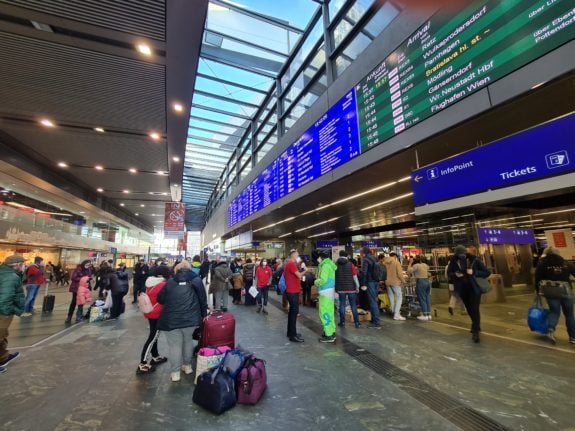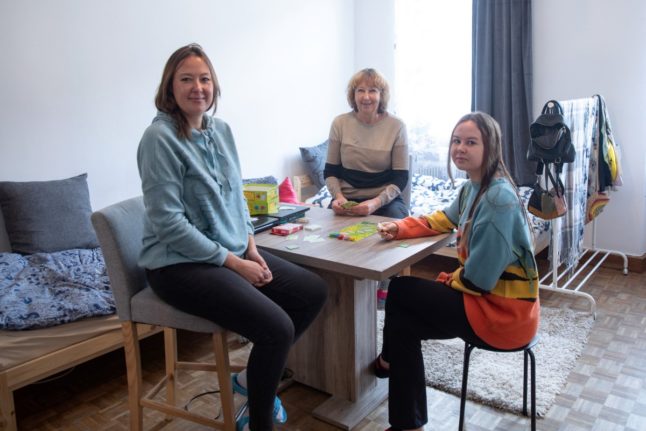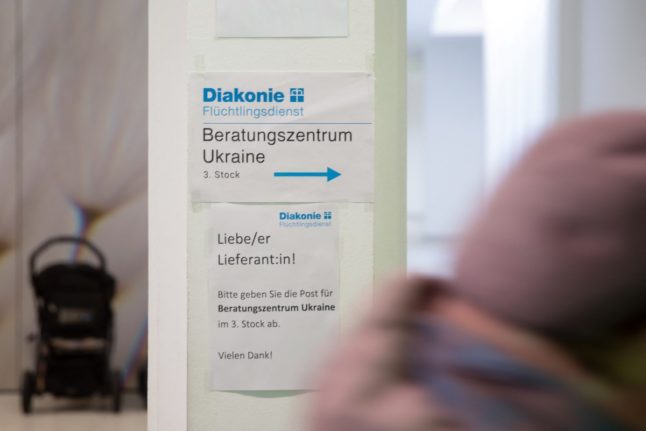Since the start of the war in Ukraine on February 24th, around 150,000 refugees are believed to have arrived in Austria.
Many have passed through to join family and friends in other countries but 7,000 people have already registered in Austria as a displaced person.
This means they can access the labour market, health care and the benefits system for a year.
There are also reports that 2,000 refugees from Moldova will soon be airlifted to Austria in cooperation with the United Nations High Commissioner for Refugees (UNHCR) and Austrian Airlines, although this has not been confirmed.
With such a large influx of people, preparations are now underway across the country to support the refugees. Find out more about how you can help here.
READ MORE: How Vienna is helping thousands of Ukrainian refugees arriving by train
Vienna
Vienna is the main arrival point for many Ukrainian refugees in Austria and an arrival centre has been set up at Ernst Happel Stadium where people can access Covid-19 testing, psychological support and beds for the night.
As a result, there is a steady stream of arrivals at Vienna’s Hauptbahnhof (Central Station) and ÖBB says there are usually 200 to 300 people onsite, although the number fluctuates as people move onto other cities or countries.
According to estimates by ÖBB, the Ministry of the Interior and the City of Vienna, 3,300 to 4,000 refugees from Ukraine arrive in Austria every day.
Travel for Ukrainian refugees is free on all train and city public transport networks in Austria (including the Wiener Linien), and over 4,000 people travelled out of Ukraine on Austria’s train network on Friday alone.
The charity Caritas is on site at Vienna’s main station around the clock. It has fifty employees on site and also mans an emergency shelter, open from 10pm, which sleeps 50 people.
Lower Austria
There are currently two arrival centres in Wiener Neustadt that can both accommodate around 100 people. Another centre is also being planned in St. Pöten for 80 to 100 refugees, as well as one in Schwechat for 50 to 70 people.
Around 6,000 private residences have already registered as accommodation for refugees from Ukraine, and organisations Caritas and Diakonie are responsible for allocating spaces.
The state government estimates there are between 700 to 1,000 refugees already in private homes in Lower Austria, with 300 people in organised accommodation and around 200 in reception centres.
READ MORE: EXPLAINED: What would ‘Austrian-style neutrality’ mean for Ukraine?
Upper Austria
It is estimated that 4,000 refugees from Ukraine are already in Upper Austria with 1,700 in emergency shelters or in accommodation provided by residents.
The registration of refugees is taking place at Linz Hauptbahnhof and the police station in Wels. Further reception centres will also be set up throughout the province.
In cooperation with the Red Cross, there are around 1,600 emergency sleeping places available in the state and more than 1,000 private homes have volunteered to host those fleeing the conflict.
Styria
A refugee arrival centre has been in operation at the Graz Messe (trade fair hall) since Wednesday where people can register and receive medical care.
There are no plans to house people in the trade hall so there are no beds at the centre. Instead, refugees will be taken to private accommodation in the community. Others have already been placed in a container village in Graz-Puntigam.
Within the first three hours of the centre opening on Wednesday, around 200 people from Ukraine were registered as displaced persons.
According to ORF, there are approximately 4,000 accommodation places available across the state but there are calls for more amid fears they will quickly run out.
Caritas estimates up to 12,000 people from Ukraine might arrive in Styria.
Burgenland
Around 600 refugees have arrived in Burgenland via bus from the Slovakia-Ukraine border, with 15 trips made in total.
Everyone was assigned private accommodation due to residents in Burgenland opening up their homes.
Further accommodation is now being sought by the state government in anticipation of further arrivals and German courses are being organised for those that have already arrived.
READ ALSO: UPDATE: Almost 120,000 refugees have arrived in Austria from Ukraine
Salzburg
Salzburg is preparing to receive around 5,000 refugees from Ukraine and a Caritas information centre is open at Salzburg Hauptbahnhof.
Temporary accommodation has already been set up in the Salzburg Exhibition Centre (Messezentrum) where refugees are being received. Others are believed to be staying with friends and family.
But there are concerns about the long-term feasibility of the Exhibition Centre location with events booked at the venue throughout the year, as reported by the Kronen Zeitung.
As an alternative, Salzburg Mayor Harald Preuner of the Austrian People’s Party (ÖVP) has suggested setting up a giant tent near the arrivals centre of the Exhibition Centre to provide temporary accommodation.
The state government is also looking for other accommodation options – both long and short term.
Tyrol
The state of Tyrol has set up four reception centres at police stations in Reutte, Lienz, Imst and Kufstein.
This is in addition to the main centre at Haus Marillac on Sennstrasse in Innsbruck where refugees can register, receive medical attention (including Covid-19 tests) and be assigned accommodation. The centre is open 24 hours a day.
There is also an information point at Innsbruck Hauptbahnhof, including signage and information in Ukrainian.
Additionally, there are calls from the Tyrolean New Austria and Liberal Forum (NEOS) to transform three hotels owned by a Russian oligarch into accommodation for refugees, as reported by The Local.
As of Thursday morning, 820 people from Ukraine had registered in Tyrol.
Vorarlberg
Bus companies in Vorarlberg are involved in delivering aid to Poland and returning with refugees to be accommodated in Austria. So far, almost two million refugees have arrived in Poland.
Caritas is also managing the offers of private accommodation and allocating places to refugees throughout the state. Apartments, houses, disused hotels and spaces in nursing homes have been offered.
Carinthia
The southern Austrian state of Carinthia is preparing for the arrival of more than 5,000 people fleeing the war in Ukraine.
Gabor Hall in Spittal is being prepared as temporary accommodation but other locations are also being sought by the state government.
Change to upper limit for Ukrainian earnings
At a federal level, refugees from Ukraine will be allowed to earn up to 485 euros a month, instead of the usual 110 euros.
The decision was announced by the Interior Minister Gerhard Karner (ÖVP) after a conference with the refugee state councillors in Austria. There will also be an increased payment of 60 euros per month for people who are housing refugees.
This means that a total of 180 euros per person is available to pay for private accommodation, broadcaster ORF reports. This extra payment will also be available for anyone housing asylum seekers.
According to Karner, 40,000 people from Ukraine have already been registered so far, and around 7,000 are now available for the job market.
Vienna City Councillor Peter Hacker estimates that 200,000 to 250,000 people from Ukraine could seek shelter in Austria in future.





 Please whitelist us to continue reading.
Please whitelist us to continue reading.
Member comments